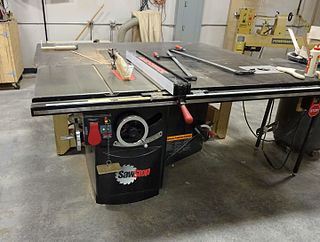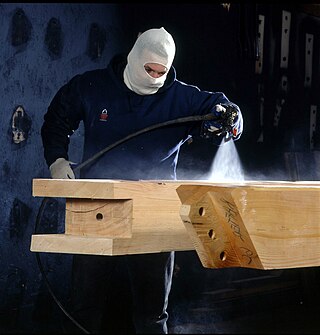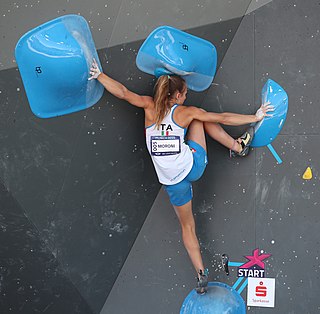Gallery
- Rubber sanding blocks
- Sanding block with a respirator
A sanding block is a block used to hold sandpaper. [1] In its simplest form, it is a block of wood or cork with one smooth flat side. The user wraps the sandpaper around the block, and holds it in place (by inserting a fitted piece of cardboard under the sandpaper, one can soften the impact on the wood and protect against tears or uneven wear on the sandpaper).
Fancier versions use clips, teeth or clamps to hold the paper in place. Commercial versions can be constructed of various materials. They are usually sized to hold a quarter or half sheet of sandpaper. Some versions use the sandpaper belts intended for a power belt sander. Construction workers often use commercial one-piece sanding blocks consisting of a foam plastic block with an abrasive coating.[ citation needed ]

A table saw is a woodworking tool, consisting of a circular saw blade, mounted on an arbor, that is driven by an electric motor. The drive mechanism is mounted below a table that provides support for the material, usually wood, being cut, with the blade protruding up through the table into the material.
An abrasive is a material, often a mineral, that is used to shape or finish a workpiece through rubbing which leads to part of the workpiece being worn away by friction. While finishing a material often means polishing it to gain a smooth, reflective surface, the process can also involve roughening as in satin, matte or beaded finishes. In short, the ceramics which are used to cut, grind and polish other softer materials are known as abrasives.

Sandpaper, also known as glasspaper or as coated abrasive, is a type of material that consists of sheets of paper or cloth with an abrasive substance glued to one face. In the modern manufacture of these products, sand and glass have been replaced by other abrasives such as aluminium oxide or silicon carbide. It is common to use the name of the abrasive when describing the paper, e.g. "aluminium oxide paper", or "silicon carbide paper".

A try square or try-square is a woodworking tool used for marking and checking 90° angles on pieces of wood. Though woodworkers use many different types of square, the try square is considered one of the essential tools for woodworking.

A paver is a paving stone, tile, brick or brick-like piece of concrete commonly used as exterior flooring. They are generally placed on top of a foundation which is made of layers of compacted stone and sand. The pavers are placed in the desired pattern and the space between pavers is then filled with a polymeric sand. No actual adhesive or retaining method is used other than the weight of the paver itself except edging. Pavers can be used to make roads, driveways, patios, walkways and other outdoor platforms.

Wood stain is a type of paint used to colour wood comprising colourants dissolved and/or suspended in a vehicle or solvent. Pigments and/or dyes are largely used as colourants in most stains.

A glazier is a tradesperson responsible for cutting, installing, and removing glass. They also refer to blueprints to figure out the size, shape, and location of the glass in the building. They may have to consider the type and size of scaffolding they need to stand on to fit and install the glass. Glaziers may work with glass in various surfaces and settings, such as cutting and installing windows, doors, shower doors, skylights, storefronts, display cases, mirrors, facades, interior walls, ceilings, and tabletops.

A sander is a power tool used to smooth surfaces by abrasion with sandpaper. Sanders have a means to attach the sandpaper and a mechanism to move it rapidly contained within a housing with means to handhold it or fix it to a workbench. Woodworking sanders are usually powered electrically, and those used in auto-body repair work are usually powered by compressed air. There are many different types of sanders for different purposes. Multipurpose power tools and electric drills may have sander attachments.
A platen is a platform with a variety of roles in printing or manufacturing. It can be a flat metal plate pressed against a medium to cause an impression in letterpress printing. Platen may also refer to a typewriter roller which friction-feeds paper into position below the typebars or print head. It can refer to the glass surface of a copier, and the rotating disk used to polish semiconductor wafers.

French polishing is a wood finishing technique that results in a very high gloss surface, with a deep colour and chatoyancy. French polishing consists of applying many thin coats of shellac dissolved in denatured alcohol using a rubbing pad lubricated with one of a variety of oils. The rubbing pad is made of absorbent cotton or wool cloth wadding inside of a piece of fabric and is commonly referred to as a fad, also called a rubber, tampon, or muñeca.

A belt sander or strip sander is a sander used in shaping and finishing wood and other materials. It consists of an electric motor that turns a pair of drums on which a continuous loop of sandpaper is mounted. Belt sanders may be handheld and moved over the material, or stationary (fixed), where the material is moved to the sanding belt. Stationary belt sanders are sometimes mounted on a work bench, in which case they are called bench sanders. Stationary belt sanders are often combined with a disc sander.

A random orbital sander is a hand-held power tool which sands in a random-orbit action. That is, in constant irregular overlapping circles. This technology was first commercially utilized in 1968 by Rupes Tools. Random orbital sanders combine the speed and aggressiveness of a belt sander with the ability to produce a finer finish than that available from a standard, slow speed orbital finishing sander. Random orbital sanders generally come in three different types: electric powered, air powered, and orbital floor sanders. The electric and air powered orbital sanders are handheld, while the floor orbital sanders are large machines that roll.

Wood finishing refers to the process of refining or protecting a wooden surface, especially in the production of furniture where typically it represents between 5 and 30% of manufacturing costs.

Distressing in the decorative arts is the activity of making a piece of furniture or object appear aged and older, giving it a "weathered look". There are many methods to produce an appearance of age and wear. Distressing is viewed as a refinishing technique although it is the opposite of finishing in a traditional sense. In distressing, the object's finish is intentionally destroyed or manipulated to look less than perfect, such as with sandpaper or paint stripper. For example, the artisan often removes some but not all of the paint, leaving proof of several layers of paint speckled over wood grain underneath. This becomes the "finished" piece.
This glossary of woodworking lists a number of specialized terms and concepts used in woodworking, carpentry, and related disciplines.

Wood flooring is any product manufactured from timber that is designed for use as flooring, either structural or aesthetic. Wood is a common choice as a flooring material and can come in various styles, colors, cuts, and species. Bamboo flooring is often considered a form of wood flooring, although it is made from bamboo rather than timber.

A climbing hold is a shaped grip that is usually attached to a climbing wall so that climbers can grab or step on it. On most walls, climbing holds are arranged in paths called routes, by specially trained route setters. Climbing holds come in a large array of sizes and shapes to provide different levels of challenge to a climber. Holds are either bolted to a wall via hex-head bolts and existing t-nuts or they are screwed on with several small screws. In extreme cases, concrete anchors may be used.

Locking clothing are garments which prevent the person wearing the clothing from removing the clothing. One example would be clothing designed to prevent a person with dementia from inappropriate undressing. Sometimes locking clothes are used for sexual purposes, such as in feminization.

Floor sanding is the process of removing the top surfaces of a wooden floor by sanding with abrasive materials.

A square is a tool used for marking and referencing a 90° angle, though mitre squares are used for 45° angles. Squares see common use in woodworking, metalworking, construction and technical drawing. Some squares incorporate a scale for measuring distances or for calculating angles.